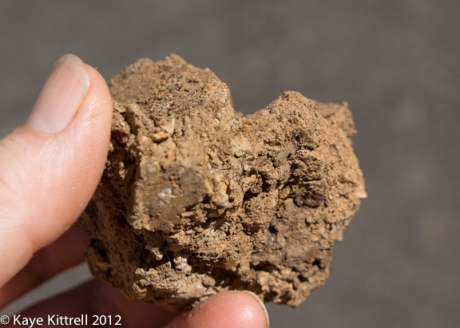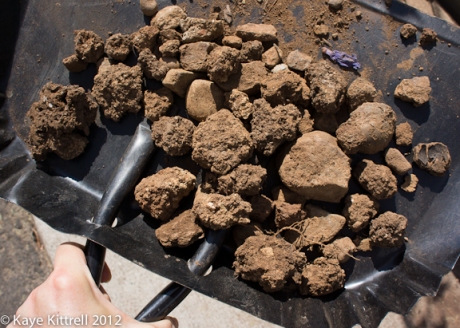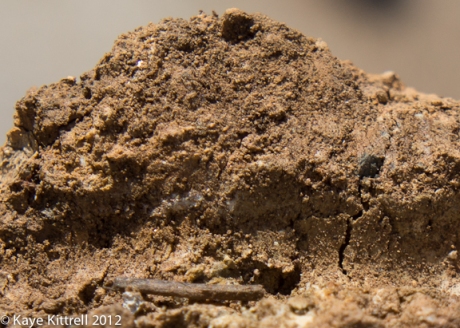Some Thoughts on Clay
Today I had Some Thoughts on Clay. This is my soil. Hard, almost hard as a rock, compacted clay. If I was a potter, or a brick maker, I would have a lifetime supply with which to work. It took a pick axe to separate this clod from the Earth.
Last fall, my son Walker helped me to remove the top eight inches of the 6.5’x20′ strip of parkway, break up the clods and put them through a 1/2″ screen and dump it back in.
I removed a ton of rocks. This took a few days, and was backbreaking, exhausting work, but, rewarding, as I believed I only had to do this job once and I would have manageable soil with which to plant a garden. A complete novice, I had no idea the earth is constantly pushing the rocks and clay up to the surface. I know now. Several folks have told me and I have seen it with my own eyes. There wasn’t a single rock bigger than a pebble six inches down when we got done with it. I could easily shove my hand in it. But, within a month or two, it was rock hard again. No matter that I have added several cubic yards of good planting mix and amendments, every time I want to plant something in the parkway, I have to get out the pick axe.
This old tool came with the house. Neighbor C.L. told me it’s so narrow on the wide end because it’s been used so much. I’ve certainly put it to work since starting my garden. I swear that anvil must weigh 10 pounds, and it’s all I can do to dig a basin-size hole in the clay to plant some milkweed or yarrow. You can see the groove where the pick separated the unwillingly clay.
Today, I dropped by Loree’s house (episode 16 of Late Bloomer) to pick up three Goose Plant milkweed plants. I didn’t have any, and they have these big, spike-y, translucent seed pods that are really cool, and like any good Monarch mother, I want to give my caterpillars as much variety as I can. Right now, I have four caterpillars and twelve milkweed plants!
I love the way it says on the instructions that, regardless of water and sun requirements, every plant wants “well-drained soil.” Ha! I dig until I’m exhausted, which usually means 14-18″ wide by 10″ deep for a 6″ potted plant, fill the basin with good soil and amendments, and hope there’s enough total cubic inches for the roots to be happy, and have to remember not to overwater it. That basin, filled with water, would take hours to soak in.
Now, don’t get me wrong, I’m not complaining. (Well, yes, I am.) My connection to my dirt is what got me started on the garden path and Late Bloomer, so, I’m grateful. But, if I had it to do over again, I would install raised beds over the whole parkway and front yard. I removed this many rocks and hard clay from two medium-sized shovelfuls of dirt today…
…to plant this 6″ pot of common yarrow. Actually, I don’t know how they can call anything this lovely “common.”
William Bryant Logan, who wrote the poetic, prophetic, historical, highly recommended account of soil, “Dirt: The Ecstatic Skin of the Earth,” knows a thing or two about clay. In fact, he devoted a whole chapter to it. I have no doubt this one clod is teeming with organic life.
Have you had Some Thoughts on Clay? It’s just that plants, especially vegetables, need good drainage for the roots. For now, I’m committed to displacing, disrupting and removing some clay here and there to create more space for my vegetables and flowers for beneficial insects. I hope the clay will forgive me for the interruption. It will be here long after I’m gone. Thanks for stopping by! – Kaye
Category: Curbside Gardening, Urban Gardening























After using that pick, I’d need a good lie down and a stiff gin!
Haha, I got those planted at 10:30 in at 10:30 in the AM. – Kaye
Oh, my gosh; I can’t imagine such rocky soil! What a workout! It looks for other post like it’s paying off: Bless you and joy in your gardening adventures, Kaye.
Thank you, Catherine! It’s just amazing how the earth squeezes rocks to the surface! Even if you lay 18″ of good planting mix on top of your clay, they come up. Thanks for the blessing and sending it back! – Kaye
Kaye don’t you just love that book!! (Dirt!) He has a new book out now that I want to read called Air. You keep swinging that pick ax and you’ll be super buff 🙂 That is real work. I’m pretty sure that gypsum helps to break down clay soils but I’d have to look up ratios and all that…it’s a thought, although on geologic time, it may take too long to be efficacious for your endeavors.
I love “Dirt!” Are you the one that recommended it to me? I can’t remember now, someone did. I am now finishing “The Secret Knowledge of Water” by Craig Childs, which is just as amazing. I’ll have to get “Air” next! 🙂 – Kaye
Wow, I want to help, but where do I start? First, clay soil is PACKED with wonderful nutrients – once its available to the plants, that is. Second? Ammend, ammend, ammend and mulch with 2-3″ of compost…
Any organic materials you can get your hands on – like nicely broken down/at least a year old animal manure, leaves, bedding straw (not hay or alfalfa, as you already found out; ), “zoo poo”… All of these will help hold moisture and allow micro organisms to help get a foothold and create a healthy Microbiome in your garden.
You also already know about the space/ventilation thing for powdery mildew, but here’s a marvellous link packed with more info from my friend, Michaela…. http://www.thegardenerseden.com/?tag=powdery-mildew-on-vegetable-crops-how-to-control
Thanks, Deb, I thought I was following The Gardeners Eden, but, realize I haven’t been getting her posts. I see she is on WordPress, but, it looks different. I will have to check it out. I think you did send me that mildew solution link before, sounds familiar. I will have to remember it next year! I just started buying a compost that has microbes that break up clay. Thing is this one strip is dotted with plants so I will have to work it in where I can. Maybe in five years it will be workable, ha. Biodynamic compost is not cheap, so I use it just around the individual plants. When I needed to have followed your advice was last fall when the whole 6.5×20′ strip was bare. I’ll do what I can. Thanks for the help! – Kaye
“Biodynamic” Compost?… Okay, so I went digging. again. (pun intended; )
Making your own is alot cheaper, indeed for next to nothing (& I’m guessing done for centuries by poor farmers in India judging by “cow’s horn” references given here; ) and you have already used Yarrow in your garden intuitively (Ha! You see? You’re plugged in without even knowing it; )
Anyway, although this article is massive, please don’t be drawn in by “complicated” terminology or arcane technique – SO much smoke and mirrors on so many things, eh? – you can see past all that; ’cause, stripped to the bone, farming is farming all the way back to the ox-drawn single-furrow plow…
http://en.wikipedia.org/wiki/Biodynamic_agriculture
Deb, I’m still planning to read this article, and I really appreciate you sending it! Thanks for writing!! – Kaye
We have rocky soil here, too (it is glacial till left over from the last ice age) and it is impossible to dig a hole of any size without having to remove as much rock as soil. In fact, even placing a wire stake is difficult (a sledge hammer required). I appreciate what you are faced with and congratulate you on your perseverance. Raised beds are a nice solution although I am still expecting to find rocks floating to the surface!
GE, I had no idea you were dealing with solid rock! No wonder you set up the lovely raised beds (and so nice and high, so you don’t have to bend over!!). Yes, I bet you will see rocks floating up at some point. Isn’t it amazing? Thanks for writing! – Kaye
Well, it is not exactly solid rock but in the middle of summer, it sure feels like it.
Glad you wrote, that reminds me I need to go get some compost to break up clay before I start planting out there today! – Kaye
I to am fighting a battle to get my clay soil to cooperate and let loose of some of it’s nutrition while at the same time allowing water to move through it faster than a glacial pace. I have been mulching heavily with shredded tree trimmings that I get for free from tree service companies. After only a year my worm population has increased immensely.
Hey, Max, thanks for liking my post and following my blog! So, are you planting veggies in your soil while you are letting the tree trimmings decompose? I have so little space, I feel I have to use well-decomposed organic matter. Tree trimmings sound like a great idea, to repurpose it! Maybe I’ll try that when I pull out my melon vines. 🙂 – Thanks! Kaye